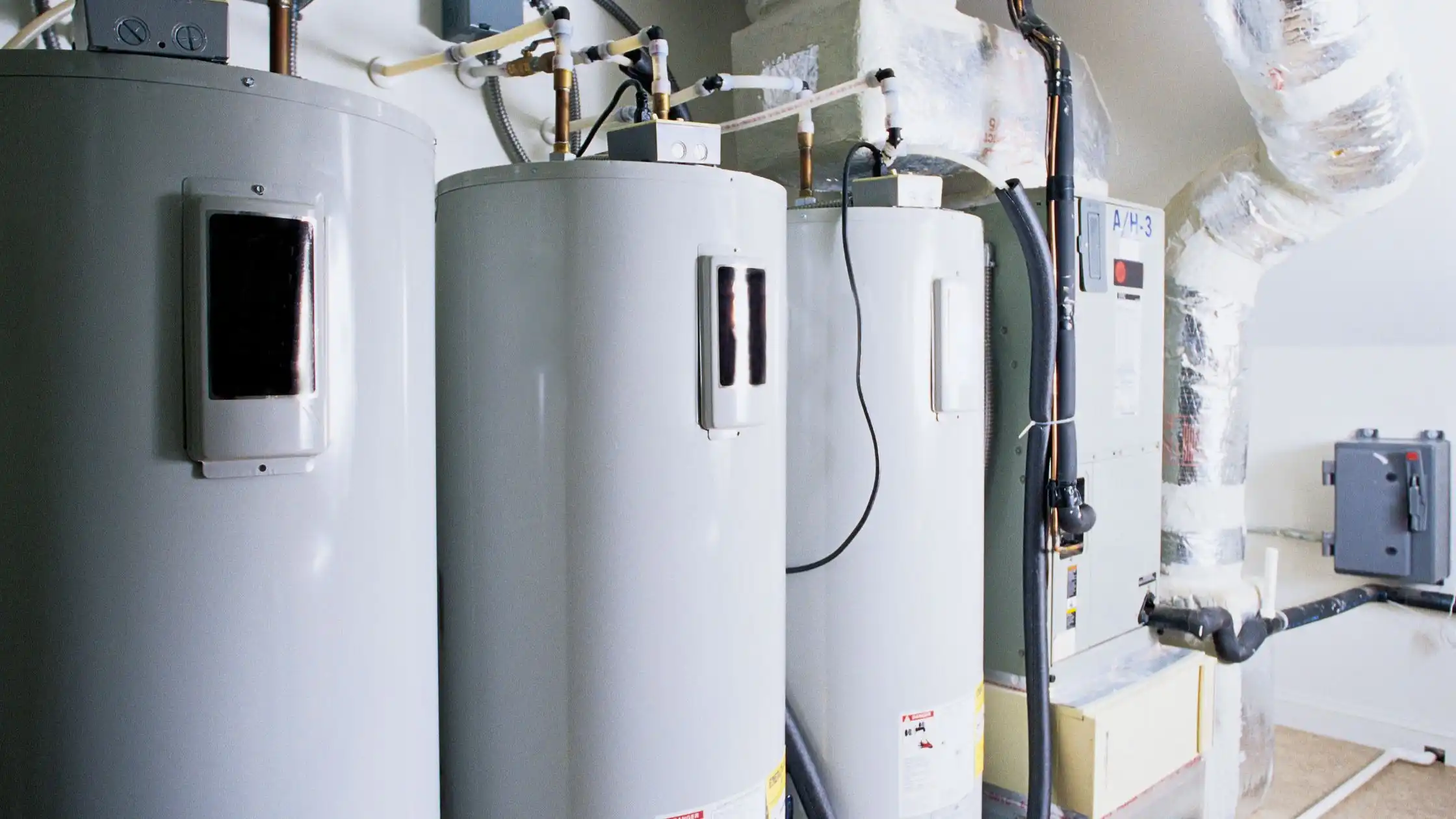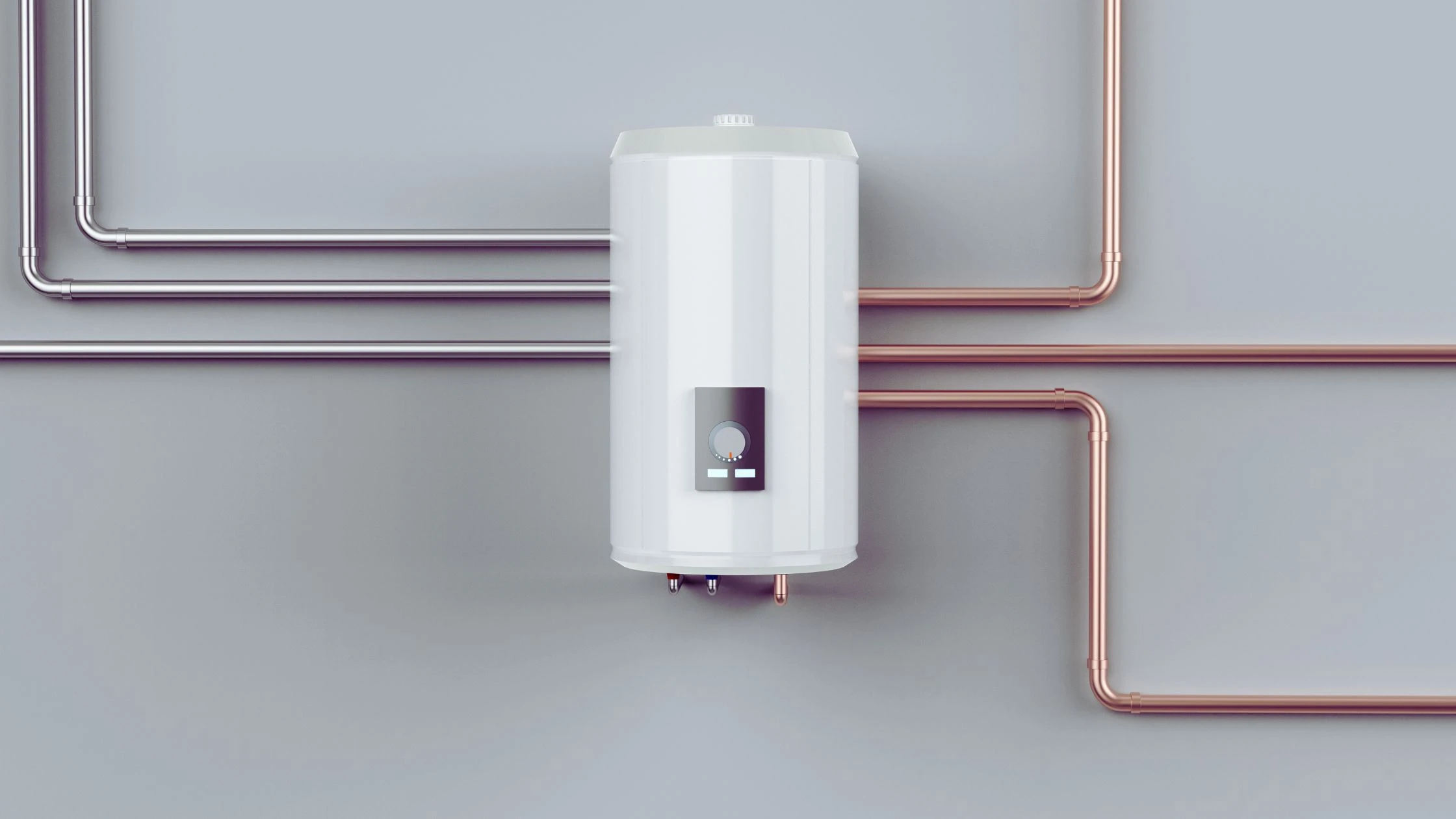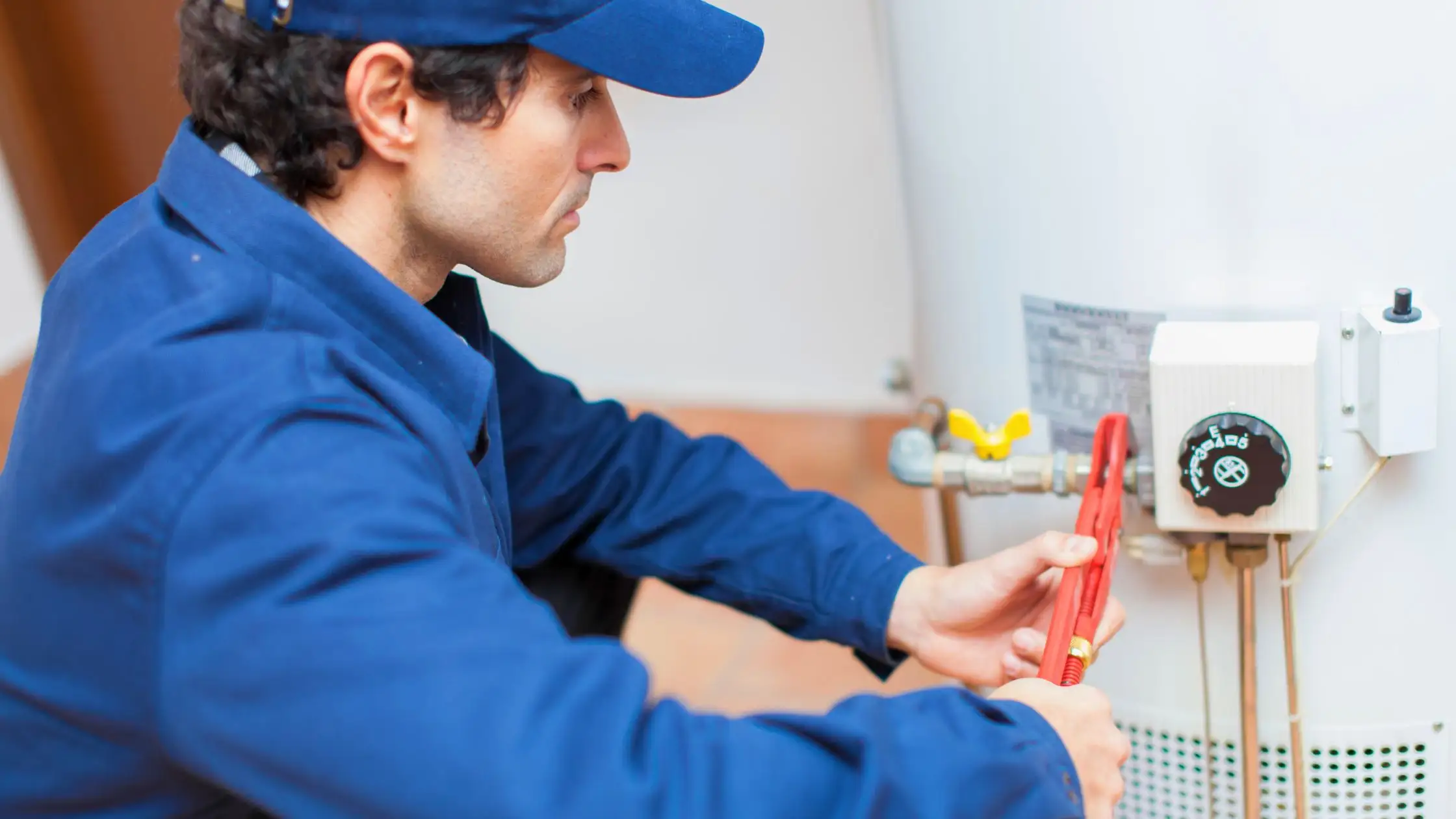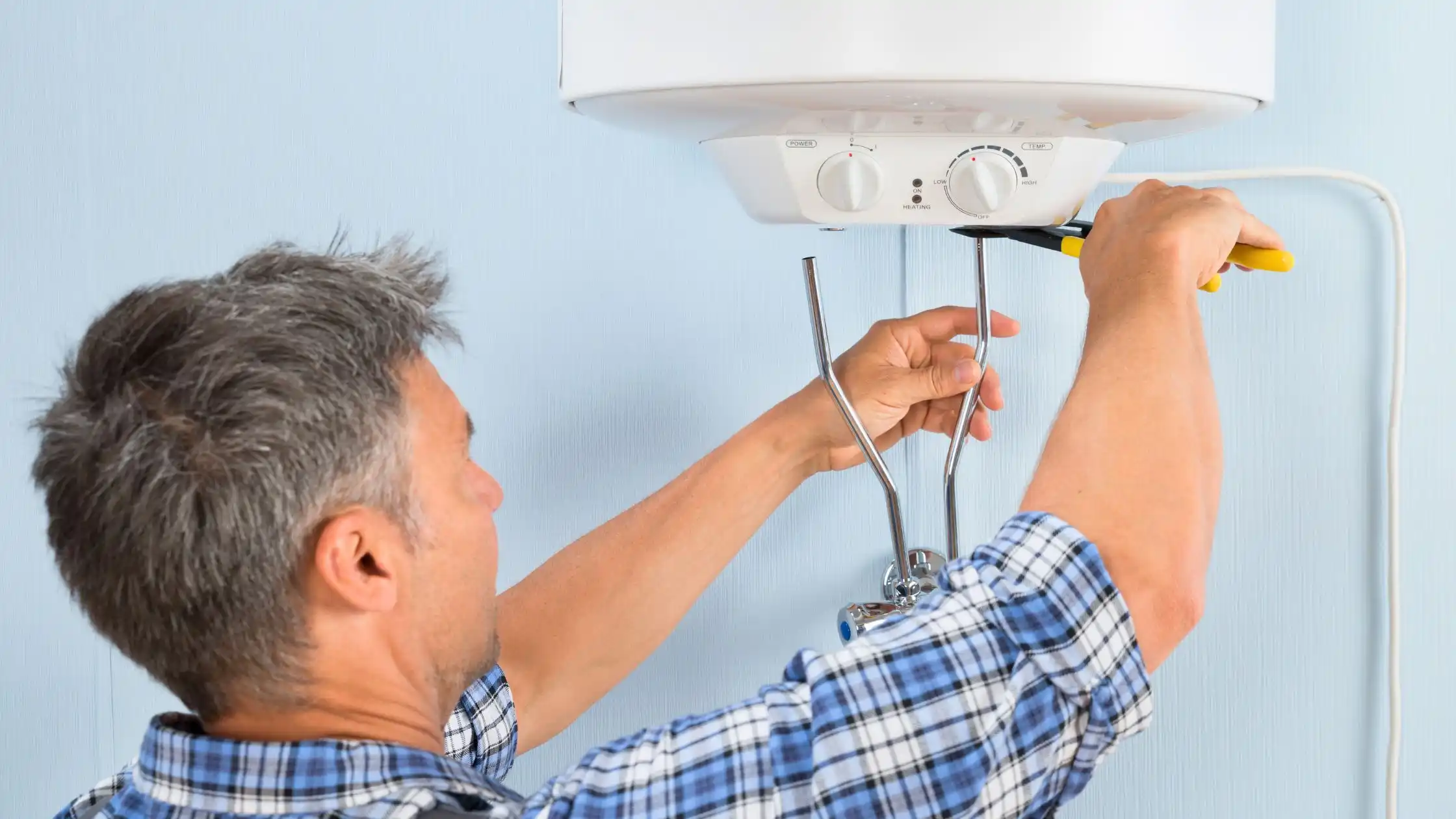If you’ve looked for a water heater, you may also have come across the term “power vent water heaters“. But what do you mean by that exactly? Consider a power vent water heater — it consists of a water heater and a blower fan designed to force the gases up and out during the heating process. Unlike classical atmospheric venting systems, where hot gases move up directly to a vent pipe just from convection, this system is powered.
In this article, we will look at what power vent water heaters are, how they work, their pros, and cons, and more. If you are thinking of buying one, this guide will provide everything you need to know.
What is a Power Vent Water Heater?
As the name suggests, a power vent water heater is a sophisticated appliance used for heating water that offers efficient as well as safe ventilation. A fan in these units pushes exhaust gases through a vent — usually horizontally — so they are ideal for homes where vertical venting is not possible. This is a system found in gas and electric water heaters, although gas models are more prevalent.
Power vent water heaters are designed to help ensure that combustion gases are vented out of the home safely. Power vent models perform more efficiently than traditional tank heaters and also provide the option of more installation locations, as they do not depend upon natural airflow to expel gases.
Power Vent Water Heater Features and Benefits
- Efficiency: These systems are crafted to be extremely effective, lowering energy use.
- Lower Installation Costs: Power vent water heaters can vent horizontally, which makes installation less complicated and less expensive.
- Increased Safety: Power vent models eliminate the need for draft pipes and ensure all gases are safely directed out of the home.
- Quiet: As these systems utilize a fan-based method for exhausting air outside, they operate relatively quietly, allowing for improved comfort levels in a home.
How Power Vent Water Heaters Work
Airflow Mechanism and Ventilation System
Power vent water heaters use a fan-assisted venting system. This assists in ejecting the exhaust gas externally and facilitates ventilation, especially when one does not have the means to vent outside. The fan sucking the gases in and pushing them out through a vent pipe specific to the fan, which can be horizontal through walls or vertical through the roof, depending on the style of the home.
The process starts with the water heater burning either gas or electric fuel to produce heat. The exhaust gases being produced during the combustion process must be safely vented to the outside. In a power vent water heater, the fan does this job, creating a forced draft, as opposed to conventional units that rely on natural draft. As a result, the exhaust fan or pumps have a full pump of the gases through the venting system, which do not allow harmful gases to build up within the home.
How They Differ from Conventional Water Heaters
Conventional water heaters generally use a natural draft to vent gases. They need a vertical vent pipe that goes up through the roof to vent exhaust gases. This approach takes advantage of the natural tendency of hot air to rise upward, which may not be preferable in some installations, particularly in homes that lack the ability for long vertical venting.
Power vent varieties, as you might have guessed, feature a built-in fan that actively forces gases through horizontal vent pipes. This makes them more versatile to install into smaller homes or buildings where headroom is tight. They are especially useful in basements, attics, or locations where a standard vertical venting system cannot be utilised. Power vent systems also can handle longer venting runs, allowing for increased flexibility in installation.
Advantages of Power Vent Water Heater
1. Energy Efficiency
Energy efficiency is often a key component in selecting a water heater. Compared to conventional water heaters, power vent water heaters offer better energy efficiency. They prevent heat from escaping during combustion as the ventilation fan aids in exhausting exhaust gases. This helps retain more heat inside the tank, reducing the amount of energy needed to keep the water temperature high.
With that, a power vent water heater’s Energy Factor (EF) rating is the measure for how energy-efficient the unit is. Many power vent units have an energy factor or EF rating that meets or exceeds the codes of energy efficiency programs such as the U.S. Department of Energy, and they are smart choices for homeowners wanting long-term saving on energy bills.
2. Space Saving
A key benefit of power vent water heaters is that they allow for space savings. A conventional water heater requires a vertical vent stack that can occupy critical real estate in a home, especially in basements or attics. Power vent water heaters, on the other hand, allow horizontal venting, so the unit can be installed in tight corners. This ability to adapt helps you position the water heater in spots that otherwise would not be appropriate for a typical unit.
Also, power vent water heaters are built to be compact and efficient, so they tend to take up less space in general as well. This means they maximize space, which makes them perfect for homeowners who need to make the most of their living space, like people who live in apartments or more diminutive homes.
3. Safety and Convenience
Power vent water heaters offer greater safety and convenience in cases where homes must meet very strict building codes. By venting exhaust gases out through the sidewall or roof, these systems reduce the risk of toxic gases, including carbon monoxide, leaking into the home.
They are also very well-suited for places that are hard to ventilate. In cases of limited vent clearance, like a basement with low ceilings or a room with poor venting capacity, power vent systems provide safe water heating without sacrificing comfort or reliability.
Types of Power Vent Water Heaters
1. Gas Power Vent Water Heaters
The most popular type of power vent water heaters is gas-powered models. My Answer 5: Fuel sources are natural gas or propane for generating heat. These models are well-suited for households with a gas supply, as they are usually more energy efficient there because gas tends to be cheaper than electricity.
Gas Power Vent Water Heaters operate just like any other gas-powered unit, but with forced draft ventilation included. Such fans help in venting combustion gases, making them safer and allowing for more flexible installation environments. They are also recognised for their faster recovery rates and greater heating capabilities, rendering them ideal for larger households with greater hot water needs.
2. Electric Power Vent Water Heaters
Those that are electric-powered utilize electricity to heat water. While they are less popular than gas models, they are an excellent choice for homes without access to natural gas. Electric power vent water heaters continue to use the fan-assisted venting system to ensure that exhaust gases vent safely.
Electric models are easier to install because they don’t need a gas line. However, they generally have a slower recovery rate than gas-powered models, meaning they may take longer to heat water. Electric vent water heaters is for an easy installation and safe, especially for the home with no gas or in a situation where it cannot be supplied (gas) can be applied.
How to Install Power Vent Water Heaters
Professional Installation vs DIY
Deciding whether to go the DIY route or with please can be one of the most critical decisions when installing a power vent water heater. Though you may save some cash in the process, hiring a professional to do the job is almost always a good idea. Requiring several venting particulars be met in the installation process, while obtaining the right materials, verifying clearances, and confirming that the system is functioning effectively.
Professional installers are trained to work by safety codes, ensuring that the water heater operates as it is meant to and does not present any hazards for your home or family. The wrong system can also end up being an expensive repair job if it is not installed correctly, so it pays to go professional.
Key Considerations During Installation
There are some key things to remember when installing a power vent water heater:
- Location: Make sure you place a heater in an accessible area that provides venting and maintenance.
- Vent Pipe Length and Material: Vent pipe should be formed at the angle required to allow an adequate exhaust gas flow.
- Clearances: Adequate clearance around the heater is essential for proper operation, particularly when it comes to venting exhaust gases.
- Power Source: Make sure the fan’s power supply is properly installed and connected.
Common Issues With Power Vent Water Heaters
Although power vent water heaters are a great choice for many, they are subject to some possible problems. As is the case with any other mechanical appliance, these units may develop issues over time. Knowing the common problems can either help you troubleshoot or determine when it’s time to call a professional to repair it.
1. Clogged Vent System
It is one of the most common problems with power vent water heaters. Over time, dirt, dust and even bird nests can build up in the vent pipes, blocking the flow of exhaust gases. That can cause the unit not to function, or worst case, carbon monoxide to seep into the home. To allow the water heater to function safely, the venting system should be maintained and cleaned regularly.
2. Fan Malfunctions
Because power vent water heaters depend extensively on a fan to blow away combustion gases, a faulty fan can cause performance problems. There is also the chance that the fan has either worn out, faced an electrical issue, or that debris has clogged the fan. A non-working fan will not allow the water heater to vent properly and can lead to overheating or a system shutdown. However, it is also necessary to maintain the fan and check if it is working properly as well.
3. Issues with the Pilot Light or Ignition (Gas Models)
Gas power vent water heaters often suffer from pilot light or ignition problems. If the pilot light is unable to light or if the ignition system is faulty, the heater does not run. This can happen because of defective thermocouples, dirty parts, or problems with the gas supply. If you are having trouble with ignition, you need to nip it in the bud to avoid worse issues down the line.
4. Overheating or Underheating
Power Vent Water Heaters: Should Maintain a Steady Water Temperature, but if the thermostat is wrong, or the heater element fails, the water temperature may no longer be constant. If the heater does not release enough hot water, it may also be a sign of a defective thermostat, sediment accumulation in the tank, or a power supply being inadequate for the heating element. Its functioning needs regular checking and maintenance to make it work at the optimal level.
Power Vent Water Heaters Maintenance Tips
Power vent water heater maintenance is important to keep it working effectively and safely. A few simple steps, and you can prolong the lifespan in your water heater and reduce the risk of costly repairs.
1. Clean the Vent System Regularly
As previously mentioned, the most common problem that you will have with power vent water heaters is a clogged venting system. It is also advisable to periodically check and clean the vent pipes to remove any debris. Dust, dirt or even insects can accumulate and clog the vent, resulting in inefficient operation or unsafe conditions. Once a year, you can avoid these issues by cleaning the vent system.
2. Check the Anode Rod
The anode rod located inside the tank prevents corrosion by attracting the minerals in the water to it and preventing the tank from rusting. The rod wears away over time and eventually has to be replaced. At least once a year, you should check the anode rod to make sure it is still working. If it’s too corroded, replace it and get some extra life out of your water heater.
3. Inspect the Heating Elements or Burner Assembly
With an electric power vent water heater, the heating elements can eventually fail. The gas models use a burner assembly. Both systems should be for wear and tear. For gas types, check that the burner sits clean and is free from debris. For electric models, the heating elements should also be inspected for damage or corrosion.
4. Check for Leaks
Check the water heater tank for any visual indication of leaks. Even minor leaks can eventually cause larger problems, so it’s a good idea to get them taken care of sooner rather than later. Leaking water may sometimes be found at the water connections, pressure relief valve or base of the tank.
5. Test the Safety Features
Most contemporary water heaters have safeguards such as temperature and pressure relief valves, high-limit switches and automatic shutoff valves. These systems work to halt overheating or perilous pressure rises. Regular testing makes sure the water heater does not put your safety at risk and helps avoid accidents.
Cost Considerations for Power Vent Water Heaters
1. Initial Purchase Cost
If you are considering a power vent water heater, the initial purchase price is a factor to consider. The average cost of a power vent water heater can be more than a regular tank water heater, depending on how much extra you have to pay for the venting system and where you live in the country. Gas-powered models cost more than electric units because gas-fired appliances are more complicated to build, requiring a fuel source and additional parts for venting.
2. Installation Costs
You can expect to pay additionally to the purchase price, with installation costs varying depending on several different factors. Overall price will depend on the complexity of the venting system, whether you are using gas versus electric fuel, and whether you are replacing an old unit or installing a new system. Professional installation is commonly suggested as the system needs to be configured correctly in order for it to operate correctly.
3. Operating Costs
Operating costs once installed vary based on factors such as energy source, efficiency of the unit, and the size of the household. Operating costs for gas-powered units are generally lower than with electric models, as gas is usually cheaper than electricity. In areas with no access to natural gas (like my home), electric power vent water heaters can be an economical solution.
4. Long-Term Value
Though the initial cost of a power vent water heater might be steeper than that of a traditional water heater, these types of heaters can save money in energy bills over time and may outlast their traditional counterparts, making the extra money spent worth it. Regular service prevents big-ticket repairs and keeps your investment paying dividends in the years to come.”
Power Vent vs. Direct Vent Water Heaters
Power vent and direct vent water heaters are alternative venting methods, but they operate differently and each has pros and cons.
Power Vent Water Heaters
- Using a fan to exhaust gases creates more venting options.
- It can also vent horizontally through a wall or vertically through the roof.
- Usually more expensive because of the fan system and extra parts.
- Ideal for homes that have limited vertical space for venting.
Direct Vent Water Heaters
- Use natural draft to push out gases, usually through a dedicated pipe.
- Easy to install and usually cheaper than power vent systems.
- Need a clear venting pathway, which may not work with all installation locations.
- Do not offer as much flexibility as power vent models, especially when venting distance is a concern.
Choosing between the two systems typically depends on your home’s layout and your heating needs. If you have the room for traditional venting and don’t need the versatility of horizontal venting, a direct vent model might save you money. But if you want a water heater that gives you more installation flexibility, a power vent may be the right water heater for you.
Also Read: Boiler vs Water Heater: Understanding the Key Differences
Conclusion
With their efficient operation, flexible installation, and safety benefits, power vent water heaters offer excellent advantages over conventional water heaters. These units, whether gas or electric, provide reliable hot water and save space and energy in your home. With proper maintenance and prompt repairs, you can extend your water heater’s lifetime and keep it running smoothly. In deciding whether a power vent water heater suits your home, consider the up-front costs, potential future savings, and your individual needs before making a purchase.









